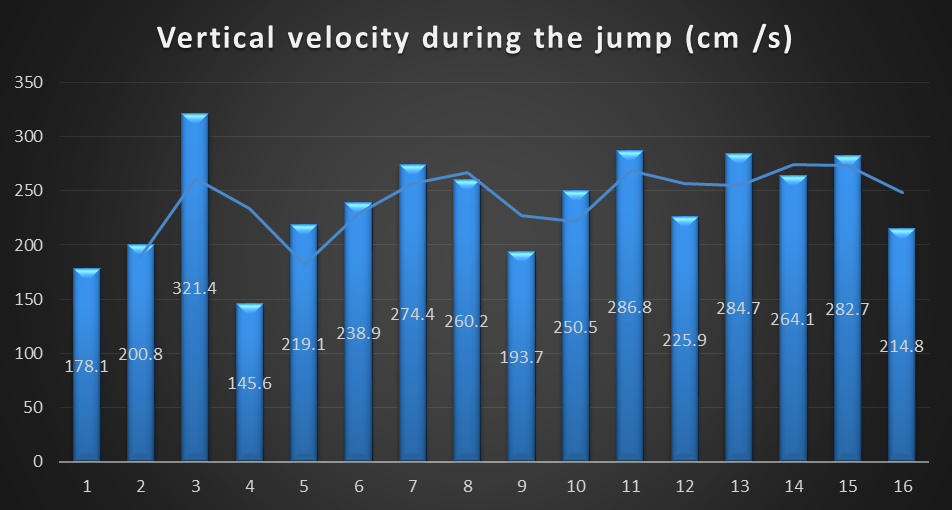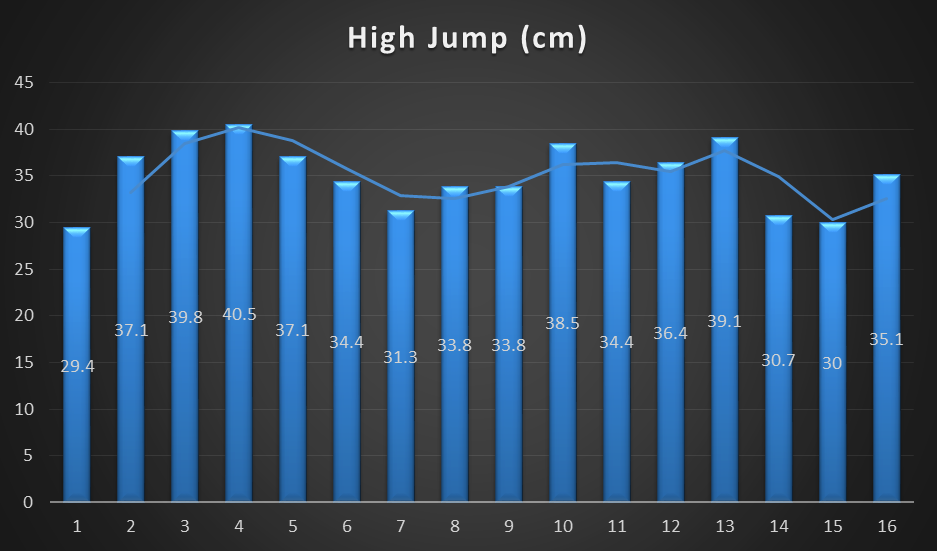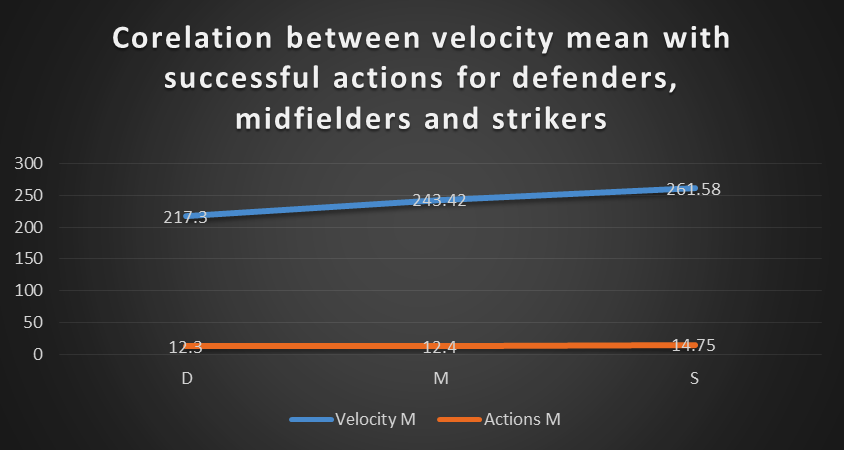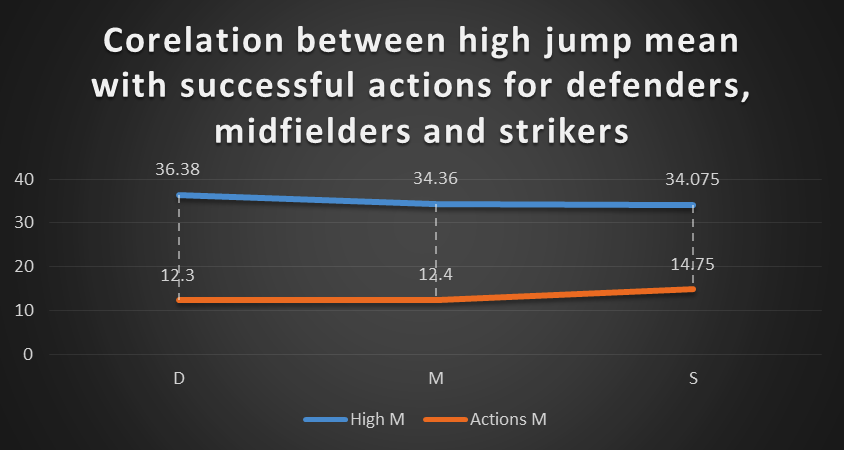Abstract
Great performances depend on the physical structure of the athlete, on one side and on the other side on the high level of psychomotricity, resulting from correct progress on basic and specific motor skills. Strength, agility and quickness are the key qualities that ease the vertical jump for players', whether it is on the attack or defence phase. In the present work we plan to do a scientific study on the indicators of the vertical jump and the efficiency of the football game for 13 year old players, on football positions. For this we achieved high precision measurements on vertical jump indicators, using the Myotest, we quantified technical actions individual positions. We have been interested to see the importance that the velocity, during the vertical jump, mean in achievement of individual technical actions at defenders, midfielders, and strikers football players. For that we realized a correlations between individual jumps and the individual technical actions from a group of 16 junior footballers, from „Brașovia” Sports Club from Brașov.
Keywords: Footballvertical jumpvelocity and high jump
Introduction
In the emerging of great performances, junior’s preparation depends on several conditions: on one
hand the athlete’s structure and on the other hand, the level of development of psychomotricity (Stein,
Gabbett, Townshend, Dawson, 2015), (Bompa, 2003). Power, agility and quickness are among the most
important qualities sought for any athlete, especially in the selections for team sports. Training these
qualities in junior age, increases the athletic performance level. (Gantiraga, Katartzi, Komsis,
Papadopoulos, 2006), (Robertson, Woods, Gastin, 2015), (Bompa, 2003). Power is considered by many
authors as a factor to develop speed, sprint and agility (Bompa, 2003), (Robertson, Woods, Gastin, 2015),
(Bompa, 2003). There are studies that affirm that exists a strong correlation between strength, sprinting,
and jumping performance in several sport activities, and also in elite football player (Wisløff, Castagna,
Helgerud, Jones, Hoff, 2004), (Glatthorn, Gouge, Nussbaumer, Stauffacher, Impellizzeri, Maffiuletti,
2011), (Ruiz, Pinillos, Molina, Latorre, 2015). We can say that lately, the performances in sport increased
at the occurrence of using high precision equipment in measuring psychomotor qualities, such as Myotest
(Gravina, Gil, Ruiz, Zubero, Gil, Irazusta, 2008), (Nuzzo, Anning, Scharfenberg, 2011), (Houel,Dinu,
Faury, Seyfried, 2011). The lack of specific physical preparation is reflected in jumping without
effectiveness, jumps that are not bringing any benefits while attacking and also creating problems in the
defence. In the present study we started from the premise that the vertical jump has a big importance in
the football game, which can make a difference in terms of the great performances (Ruiz, Pinillos,
Molina, Latorre, 2015),
Talking about junior football players, it is very important to have these data at these ages, for future
preparing. The athletic performance level has greatly increased as a result from the rigorous scientific
research, who offers optimized scientific solutions for the physical preparation of the players. (Houel,
Dinu, Faury, Seyfried, 2011); (Wisløff, Castagna, Helgerud, Jones, Hoff, 2004); (Glatthorn, Gouge,
Nussbaumer, Stauffacher, Impellizzeri, Maffiuletti, 2011), (Samozino, Morin, Hintzy, Belli, 2008).
Measurements done with high precision equipment gives us a high degree of confidence compared to
previously manual recordings (Houel,Dinu, Faury, Seyfried, 2011), (Casartelli, Müller, Maffiuletti,
2010). Coaches are the first beneficiaries of these study results who have been waiting for a long time for
a restructuring concept, methodically speaking (Grosu 2013). They can streamline the junior game
following the analysis of statistical data and performing correlations between the results obtained from
measurements carried out and the tactical and technical actions of the junior football players.
Research Design
The Study Purpose, and Objectives
The purpose of research is to perform high precision measurements for jumping indicators at the
junior football players. The objectives were to create a statistical analysis of the height and velocity of a
vertical jump in football, and performing statistical correlations of these, at the junior football players, on
posts.
The Research Data
The study was realized at „Brașovia” Sports Club from Brașov, on a group of 16 athletes of 13
years old with the approval of the club and parents. The subjects were 6 defenders, 6 midfielders and 4
forwards with heights of 165,5±17,5 cm, having 55,87±15 kg.
The Research Methodology
To achieve this research, the athletes executed a vertical cmj jump and we used the Myotest device
as a quantification and validation instrument for the muscular evolution. Myotest consists of an
accelerometer, a fastening device and software which allow the graphical representation of motion and
the analysis of muscle activity.

In the second part of the research, to determine the football technical level, in terms of heading
technique, the athletes were divided on field posts and done 20 exercises as follows:
•The defenders with an active opponent, inside of their own 11m penalty area, they had to head the
ball which is sent from different areas of the field. The number of successful actions was counted.
•Regarding the midfielders and strikers, the actions were counted as successful when the ball was
won and sent to the goal.
Results. Analysis and Interpretation
The tests results are collected and summarized in the table
In terms of velocity during the vertical jump, the following statistical data were obtained:
The mean of the group is240,11 cm/s, the best result being 321,4 cm/s, namely 81,29 cm above the group’s mean.
The second time, ie 286,8 cm/s, was situated at a considerable difference, being 34,6 cm/s lower than
the first result;
The lowest recorded velocity is 145,6 cm/s, being 94.4 cm/s slower than the group’s mean.
The median is 244,7 cm/s, which is 4,59 cm/s higher than the mean, but there are no results between the two values, which allows us to affirm that they are substantially equal; The standard deviation is 46,63 towards the lower data. Three results are below 200 cm/s, which are
pulling the groups mean down, 4 results are situated between 200 cm/s and 240 cm/s, 7 results are
situated between 250 cm/s and 287 cm/s, which demonstrates a reduced homogeneity of these
statistical data. The graph has a normal distribution, with a large range of distribution which can be
seen in the image below:

Regarding the height of the jump, the following statistical data were obtained:
The mean of the data of the height of the jump was 35,09 cm, the highest jump 40,5 cm, with 5 cm above the group average, and the lowest jump was 29,4 cm, with 6 cm below the group average. The median data group was 34,4 cm, that’s mean 0,69 cm smaller than the mean, 2 athletes even
obtained this result. We can say that the mean and median are approximately equal; the graph having
a normal distribution.
The standard deviation is 3,51, that means that the group was homogeneous in terms of the height of
the jump, as can be seen from Figure

After the statistical analysis of the velocity and high of the vertical jump, we quantified this data,
and correlated it with individual technical actions, at the defenders, midfielders and strikers junior
football players. The results are presented in the table

We can observe (Figure
approximately equal, ie 12,3 and 12.4 respectively, of the total of 20, which represents 61,5%, and 62%.
The strikers have the best mean of the vertical jump speed which is 261.58 cm/s, while the defenders have
the lowest average which is 217,3 cm/s. We can say that the strikers have more successful actions (2,35
more than the defenders) due to higher speed in the vertical, in other words they arrive first at the ball and
can successfully complete the actions of attack. At a speed of 261,58 cm/s of the vertical jump, the
strikers can solve 70% of the technical actions, and at a speed of 217,3 cm/s, the defenders are solving
61,5% of their technical actions.

Regarding the correlation between the height of the jump and the successful actions, in figure
see that the defenders had the highest average of the height of the jumps (36,38 cm) followed by
midfielders (34,36 cm), then by forwards with 34,07cm. The defenders have the smallest average of the
successful actions, namely 12,3 which is just 0,1 lower than the midfielders (12,4) the strikers have the
highest average, 14,75 successful actions. The strikers, who have the lowest average of the height of the
jump, have the most successful technique actions and the defenders which have the highest average of the
highest of the jump, have the least successful number of actions. So at a height jump of a minimum 34 cm
can be solved successfully between 60% and 70% of the technical actions of the corresponding positions.
The height of the jump does not have a great importance in achieving technical actions as the speed has in
the vertical jump.
Conclusion
By making high precision measurements, using Myotest, regarding the vertical jump indicators of
the junior football players the purpose and one of our objectives of the research have been achieved.
The second objective of the work was accomplished through statistical analysis of the collected
data. Thus we can say that the group is not homogeneous regarding the vertical speed indicator during the
jump, the time between the first and the last having a difference of 175,8 cm/s. the graph has a normal but
a large distribution, the subject with the best result at this indicator, ranks second at the height of the jump
indicator.
Regarding the height of the jump, the results of the group are homogenous, the mean and median
have a difference of only 0,69. Between the mean of the jump and the best jump the difference is almost 5
cm, and between the mean and the worst jump, the difference is almost 6 cm.
The analysis of the results obtained from the specific technical actions of game positions, lead us
to the conclusions that the strikers, with 70,3% rate of successful actions have the best results, midfielders
with 62% and defenders with 61,5% successful actions have close results but with almost 10% lower than
the strikers.
We conclude that for an increased efficiency of the game head, what matters in the game’s
economy at the junior football players is the speed during the jump, at the expense of vertical height,
which has been shown especially at the strikers. Players that have the height of the jump at least equal with the group’s mean can solve efficiently between 60-70% of the head technique actions. In order that
the strikers to have 70,3% successful actions, they need to have at the vertical speed results with 18 cm/s
better than midfielders and with 44,28 cm/s better than defenders.
Acknowledgements
The professional Myotest device, was acquired through the structural funds project: „RTD Institute: High-tech Products for Sustainable Development” (ID123, SMIS 2637, ctr. No. 11/2009).
References
- Bompa, T. (2003). Performața în jocurile sportive. Editura Ex Ponto, București.
- Casartelli, N. & Müller, R. & Maffiuletti, N.A. (2010). Validity and Reliability of the Myotest
- Accelerometric System for the Assessment of Vertical Jump Height. The Journal of Strenght and Conditioning Research, 24(11), 3186-3193.
- Castagna, C. & Castellini, E. (2013). Vertical jump performance in Italian male and female national team soccer players. Journal of Strength and Conditioning Research, 27(4), 1156-1161.
- Gantiraga, E. & Katartzi., E. & Komsis, G. & Papadopoulos, C. (2006). Strength and vertical jumping performance characteristics in school-aged boys and girls. Biology of Sport, 23(4), 367-378.
- Glatthorn, J.F. & Gouge, S. & Nussbaumer, S. & Stauffacher, S. Impellizzeri, F.M. Maffiuletti, N.A.
- (2011). Validity and reliability of optojump photoelectric cells for estimating vertical jump height. The Journal of Strenght and Conditioning Research, 25(2), 556–560.
- Gravina, L. & Gil, S. & Ruiz, F. & Zubero, J. & Gil, J. & Irazusta, J. (2008). Anthropometric and Physiological differences between first team and reserve soccer players aged 10-14 at the beginning and end of the season. Journal of Strenght and Conditioning Researchm 22(4), 1308-1314.
- Grosu, B. (2013). Fotbalul și psihomotricitatea la copiii de 8-10 ani. Editura Didactică și Pedagogică Houel, N. & Dinu, D. & Faury, A. & Seyfried, D. (2011). Accuracy and reliability of the Myotest Pro system to evaluate a squat jump. Science Direct, 13, 434-438.
- Nuzzo, J.L. & Anning, J.H. & Scharfenberg, J.M. (2011). The reliability of three devices used for measuring vertical jump height. The Journal of Strenght and Conditioning Research, 25(9), 2580–2590 Stein, J.G. & Gabbett, T.J. & Townshend, A.D & Dawson, B.T. (2015). Physical qualities and activity profiles of sub-elite and recreational Australian football players. Journal of Science and Medicine in Sport, 18(6), 742-747.
- Robertson, S. & Woods, C. & Gastin, P. (2015). Predicting higher selection in elite junior Australian Rules football: The influence of physical performance and anthropometric attributes. Journal of science and medicine in sport, 18(5), 601-606.
- Ruiz, A.R. & Pinillos, F.G & Molina, A. & Latorre, R.P. (2015). Influence of Competition on Vertical Jump, Kicking Speed, Sprint and Agility of Young Football Players. South African Journal for Research in Sport, 37(2), 109-118.
- Samozino, P. & Morin, J.B. & Hintzy & Belli A. (2008). A simple method for measuring force, velocity and power output during squat jump. Journal of Biomechanics, 41, 2940-2945 Wisløff, U. & Castagna, C. & Helgerud, J. & Jones, R. Hoff, J. (2004). Strong correlation of maximal squat strength with sprint performance and vertical jump height in elite soccer players. Journal of Science and Medicine in Sport, 38, 285–288.
Copyright information

This work is licensed under a Creative Commons Attribution-NonCommercial-NoDerivatives 4.0 International License.
About this article
Publication Date
25 May 2017
Article Doi
eBook ISBN
978-1-80296-022-8
Publisher
Future Academy
Volume
23
Print ISBN (optional)
-
Edition Number
1st Edition
Pages
1-2032
Subjects
Educational strategies, educational policy, organization of education, management of education, teacher, teacher training
Cite this article as:
Gugu-Gramnatopol, C., Ochiotan, Ș., Ionescu, A., & Dăncescu, D. (2017). Correlation Between Speed and Height Jump in Junior Football Players. In E. Soare, & C. Langa (Eds.), Education Facing Contemporary World Issues, vol 23. European Proceedings of Social and Behavioural Sciences (pp. 883-889). Future Academy. https://doi.org/10.15405/epsbs.2017.05.02.108

